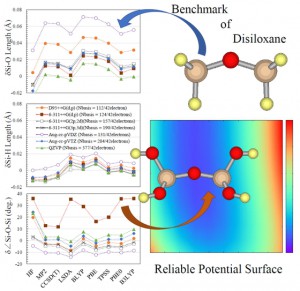[Published online Journal of Computer Chemistry, Japan -International Edition Vol.5, -, by J-STAGE]
<Title:> Revisiting the Nature of Si-O-Si Bridging
<Author(s):> Fumiya NORITAKE
<Corresponding author E-Mill:> fnoritake(at)yamanashi.ac.jp
<Abstract:> Non-empirical calculation based on the Schr dinger equation is an appropriate tool for investigating the relationship among Si-O-Si angle, Si-O bond length, Si-O bond strength, and electronic structure. However, past studies could not reach a consensus about the equilibrium structure of the C2v pyrosilisic acid molecule. Moreover, the structure of disiloxane, the simplest siloxane molecule, could not be reproduced using non-empirical molecular orbital calculations. In this study, I checked the reproducibility of various model chemistries and basis sets, and found that employing the post-Hartree-Fock method and a larger basis set (at least, aug-cc-pVTZ) is necessary for accurate calculation of the disiloxane molecule. In contrast to past studies on molecular orbitals, the present study reveals no significant occupancy in the Si 3d orbitals. The total energy landscape of the C2v pyrosilisic acid molecule is calculated by using the coupled cluster method concerning three excited electrons and the aug-cc-pVTZ basis set. The stable bond length for Si-Obr is 1.604 , and the stable Si-O-Si angle is 159.449°. There are gentle curves around the stable angles for each bond length comparing with bond length direction. The stable angle for each bond length decreased with increasing Si-Obr bond length. The weakening of the Si-Obr bond with decreasing Si-O-Si bond angle can be explained by the decrease in the bond index and the increase in the orbital energy for Si-Obr σ-bond. Consequently, hybridization of the valence electrons of the bridging oxygen with decreasing Si-O-Si angle weakens the Si-Obr σ-bond. Electrostatic potential favors a straight configuration because of the repulsion between the SiO4 tetrahedra, while the valence electrons of the bridging oxygen favor a bent configuration. These two competing behaviors can explain the bent configuration of pyrosilisic acid without considering d-p π bonding.
<Keywords:> SIlicate, Pyrosilisic Acid, Disiloxane, Benchmark, Molecular Orbital Calculations
<URL:> https://www.jstage.jst.go.jp/article/jccjie/5/0/5_2018-0016/_html
